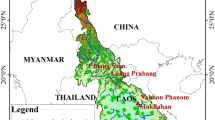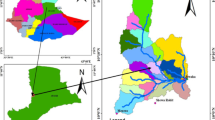Abstract
The purpose of this paper is to apply “Soil and Water Assessment Tool (SWAT)” model to assess the impacts of climate change on stream discharge and sediment yield from Song Cau watershed in Northern Viet Nam. Three climate change scenarios B1, B2, and A2; representing low, medium, and high levels of greenhouse gas emission, respectively, were considered in this study. The highest changes in stream discharge (up to 11.4%) and sediment load (15.3%) can be expected in wet season in 2050s according to the high emission scenario (A2), while for the low emission scenario the corresponding changes equal to 8.8% and 12.6%. The results show that the stream discharge is likely to increase in the future during the wet season with increasing threats of sedimentation.
Similar content being viewed by others
References
Arnold, J.G., Allen, P.M., and Morgan, D.S., Hydrologic Model for Design and Constructed Wetlands, Wetlands, 2001, vol. 21, no. 2, pp. 167–178.
Arnold, J.G., Srinivasan, R., Muttiah, R.S., and Williams, J.R., Large Area Hydrologic Modeling and Assessment. Part 1: Model Development, J. of Amer. Resource Assoc., 1998, vol. 34, no. 1, pp. 73–89.
Bagnold, R.A., Bedload Transport in Natural Rivers, Water Resour. Res., 1977, vol. 13, no. 2, pp. 303–312.
Chapra, S.C., Surface Water-Quality Modeling, New York: McGraw-Hill, 1997.
Gosain, A.K., Rao, S., and Basuray, D., Climate Change Impact Assessment on Hydrology of Indian River Basins, Current Sci., 2006, vol. 90, no. 3, pp. 346–353.
GSOV (General Statistics Office of Viet Nam). Statistical Year Book 2008, Ha Noi: National Political Publishing House, 2008.
Gupta, H.V., Sorooshian, S., and Yapo, P.O., Status of Automatic Calibration for Hydrologic Models: Comparison with Multilevel Expert Calibration, Journal of Hydrologic Engineering, 1999, vol. 4, no. 2, pp. 135–143.
Hiroaki, S., and Ikuo, T., Numerical Analyses on Seasonal Variations of Nutrient Salts and Load Discharges in Abashiri River Basin, 2009 International SWAT Conf. Proc., 2009, pp. 241–248.
Intergovernmental Panel on Climate Change (IPCC) Working Group I. Climate Change 2001: the Scientific Basis. Contribution of Working Group I To the Third Assessment Report of the IPCC, Cambridge: Cambridge University Press, 2001.
Johns, T.C., Carnell, R.E., Crossley, J.F., et al., The second Hadley Centre coupled ocean-atmosphere GCM: Mode description, spinup, and validation, Clim. Dynam., 1997, vol. 13, no. 2, pp. 103–134.
Karaburun, A., Estimation of C Factor for Soil Erosion Modeling Using NDVI in Buyukcekmece Watershed, Ozean Journal of Applied Science, 2010, vol. 3, no. 1, pp. 77–85.
Keshta, N., Elshorbagy, A., and Carey, S., A Generic System Dynamics Model for Simulating and Evaluating The Hydrological Performance of Reconstructed Watersheds, J. Hydrol. Earth Syst. Sci., 2009, vol. 13, pp. 865–881.
MORE (Ministry of Natural Resources and Environment). Climate change, Sea Level Rise Scenarios for Viet Nam, Ha noi, 2009.
Moriasi, D.N., Arnold, J.G., Van Liew, M.W., et al., Model Evaluation Guidelines for Systematic Quantification of Accuracy in Watershed Simulations, Trans. ASABE, 2007, vol. 50, pp. 885–900.
Muttiah, R.S. and Wurbs, R.A., Modeling the Impacts of Climate Change on Water Supply Reliabilities, Intl. Water Resources, 2002, vol. 27, no. 3, pp. 407–419.
Nash, J.E.. and Sutcliffe, J.V., River Flow Forecasting through Conceptual Models. Part I-A Discussion of Principles, J. Hydrology, 1970, vol. 10, no. 3, pp. 282–290.
Nguyen, K.L., and Nguyen, V.T., Assessing Climate Change Impacts and Adaptation in Central Viet Nam Using Watershed and Community Based Approach: Case Study in Quang Nam Province, 2011 International SWAT-SEA Conference Proceedings, 2011, pp. 125–137.
Nearing, M.A., Jetten, V., Baffaut, C., et al., Modeling Response of Soil Erosion and Runoff to Changes in Precipitation and Cover, Catena, 2005, vol. 61, nos. 2–3, pp. 131–154.
Neitsch, S.L., Arnold, J.G., Kiniry, J.R., and Williams, J.R., Soil and Water Assessment Tool Theoretical Documentation, Version, 2005a, Temple, Tex.: USDA-ARS Grassland, Texas: Soil and Water Research Laboratory, 2005.
Panagopoulos, I., Mimikou, M., and Kapetanaki, M., Estimation of Nitrogen and Phosphorus Losses to Surface Water and Groundwater through the Implementation of the SWAT Model for Norwegian Soils, J. of Soils & Sediments, 2007, vol. 23, no. 4, pp. 95–105.
Phan, D.B., Wu, C.C., and Hsieh, S.C., Impact of Climate Change and Deforestation on Stream Discharge and Sediment Yield in Phu Luong Watershed, Viet Nam, J. Envir. Science and Engineering, 2011, vol. 5, no. 1, pp. 92–101.
Rosenberg, N.J., Brown, R.A., Izaurralde, R.C., and Thomson, A.M., Integrated Assessment of Hadley Centre (HadCM 2) Climate Change Projections in Agricultural Productivity and Irrigation Water Supply in the Conteminous United States: I Climate Change Scenarios and Impacts on Irrigation Water Supply Simulated with the HUMUS Model, Agric. For. Meteor., 2003, vol. 117, no. 1–2, pp. 73–96.
Rosenberg, N.J., Epstein, D.L., Wang, D., Vail, L., et al., Possible Impacts of Global Warming on the Hydrology of the Ogallala Aquifer Region, Clim. Change, 1999, vol. 42, no. 4, 677–692.
Santhi, C., Arnold, J.G., Williams, J.R., et al., Validation of the SWAT Model on A Large River Basin with Point and Nonpoint Sources, J. Am. Water Resour., 2001, vol. 37, no. 5, pp. 1169–1188.
Santhi, C., Srinivasan, R., Arnold, J.G., and Williams, J.R., A Modeling Approach to Evaluate the Impacts of Water Quality Management Plans Implemented in a Watershed in Texas, J. Envir Modelling & Software, 2006, vol. 21, pp. 1141–1157.
Sharpley, N., and Williams, J.R., EPIC-Erosion Productivity Impact Calculator Model Documentation, U.S. Department of Agriculture, Agricultural Research Service, Tech. Bull., 1990.
Semenov, M.A., and Barrow, E.M., LARS-WG: A Stochastic Weather Generator for Use in Climate Impact Studies, User Manual, 2002.
Spruill, C.A., Workman, S.R., and Taraba, J.L., Simulation of Daily and Monthly Stream Discharge from Small Watersheds Using the SWAT Model, Trans. ASAE, 2000, vol. 43, no. 6, pp. 1431–1439.
Williams, J.R., Jones, C.A., and Dyke, P.T., A Modeling Approach to Determining the Relationship between Erosion and Soil Productivity, Trans. of the ASABE., 1984, vol. 21, pp. 129–144.
Wischmeier, W.H., and Smith, D.D., Predicting Rainfall Erosion Losses—A Guide to Conservation Planning, US Department of Agriculture, Agricultural Handbook, 1978, no. 537.
Author information
Authors and Affiliations
Additional information
The article is published in the original.
Rights and permissions
About this article
Cite this article
Phan, D.B., Wu, C.C. & Hsieh, S.C. Impact of climate change on stream discharge and sediment yield in Northern Viet Nam. Water Resour 38, 827–836 (2011). https://doi.org/10.1134/S0097807811060133
Received:
Published:
Issue Date:
DOI: https://doi.org/10.1134/S0097807811060133




